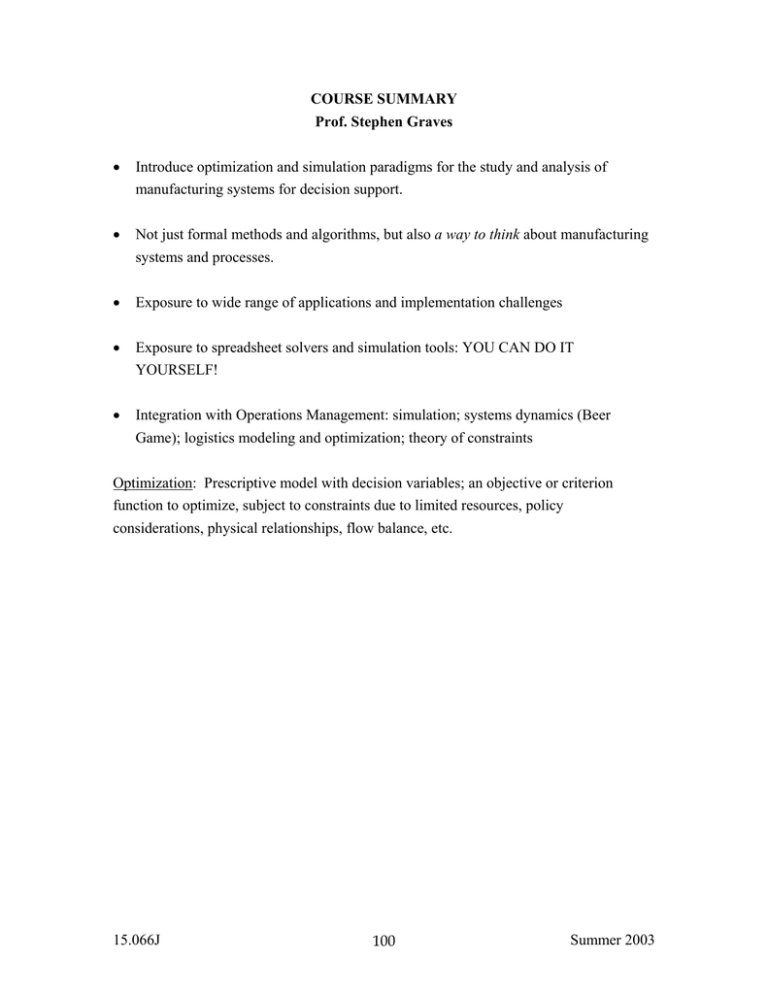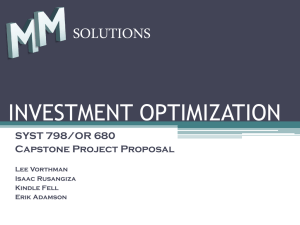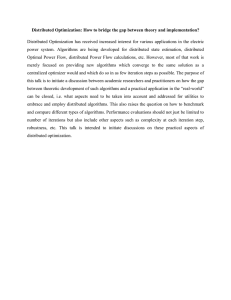COURSE SUMMARY Prof. Stephen Graves
advertisement

COURSE SUMMARY Prof. Stephen Graves • Introduce optimization and simulation paradigms for the study and analysis of manufacturing systems for decision support. • Not just formal methods and algorithms, but also a way to think about manufacturing systems and processes. • Exposure to wide range of applications and implementation challenges • Exposure to spreadsheet solvers and simulation tools: YOU CAN DO IT YOURSELF! • Integration with Operations Management: simulation; systems dynamics (Beer Game); logistics modeling and optimization; theory of constraints Optimization: Prescriptive model with decision variables; an objective or criterion function to optimize, subject to constraints due to limited resources, policy considerations, physical relationships, flow balance, etc. 15.066J 100 Summer 2003 Linear Programs: • pervasive, many applications • easy to solve via readily-available, general-purpose codes • very robust algorithms • concept of shadow prices, i. e., marginal value of constrained resource • importance of sensitivity analysis and what if’s • some art required to build successful (large) application Network Flow Problems • pervasive, many applications for modeling flows in manufacturing, transportation, telecommunication systems etc. • very powerful algorithms – specialization of LP Stochastic Programs • very important (and interesting) extension to LP to incorporate uncertainty for dynamic decision contexts • very computationally intensive • starting to see a few large-scale applications; should be common-place in next ten years. Integer, Nonlinear Programs: • pervasive, many applications • problems of modest size are readily solvable • algorithms quite different from that for LP • commercial codes available for IP and NLP, but not as powerful or robust as for LP – but they keep getting better and better • much more art needed for building successful application - both in modeling and in choice and tuning of algorithms • IP is very useful for modeling economy of scale effects; for discrete choices, e. g., in system or network design, or investment decisions; and for scheduling and routing decisions. • For IPs, computational time can be major concern in routine applications --in which case, heuristic procedures are often warranted. • Engineering design and optimization of design parameters are good application context for NLPs. Another common context is process optimization, where the control parameters are the decision variables. • For NLPs, not able to assure global optimum is found 15.066J 101 Summer 2003 Simulation • most common tool for modeling manufacturing systems • descriptive modeling, very powerful tool for capturing uncertainty in complex systems • a variety of software tools exist for building simulation models ranging from spreadsheet add-ins to simulation programming languages • capability for numerical experimentation of existing and planned systems • design of simulation entails identifying state space for system and events that result in state transitions. • issues with simulation include appropriate level of detail; model validation; design of experiments and interpretation and analysis of output for decision support Decision Analysis • powerful framework for representing and structuring multi-stage decisions, subject to uncertainty • based on underlying set of axioms for rational decision making • most applicable for one-time decision contexts with large risks • very useful for assessing value of information or sampling • formalizes concept of maximizing utility 15.066J 102 Summer 2003


